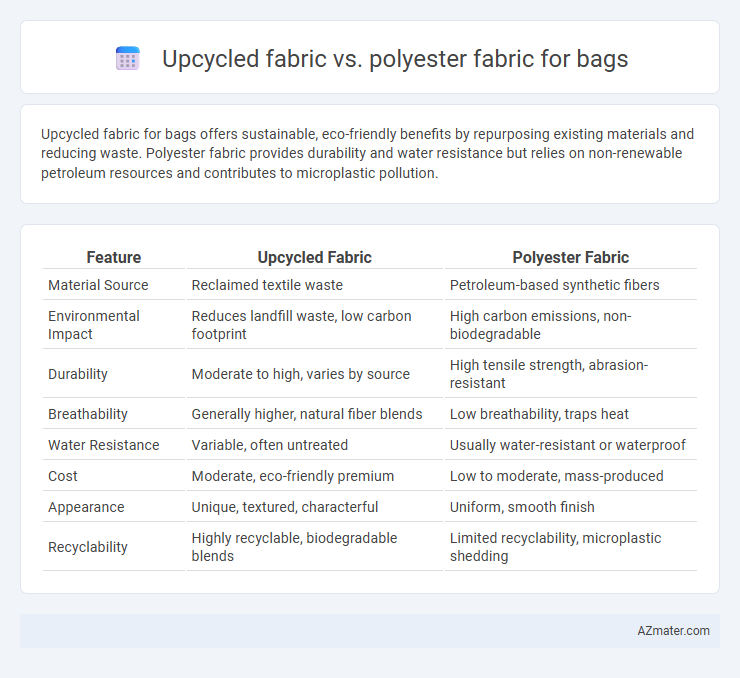Upcycled fabric for bags offers sustainable, eco-friendly benefits by repurposing existing materials and reducing waste. Polyester fabric provides durability and water resistance but relies on non-renewable petroleum resources and contributes to microplastic pollution.
Table of Comparison
| Feature | Upcycled Fabric | Polyester Fabric |
|---|---|---|
| Material Source | Reclaimed textile waste | Petroleum-based synthetic fibers |
| Environmental Impact | Reduces landfill waste, low carbon footprint | High carbon emissions, non-biodegradable |
| Durability | Moderate to high, varies by source | High tensile strength, abrasion-resistant |
| Breathability | Generally higher, natural fiber blends | Low breathability, traps heat |
| Water Resistance | Variable, often untreated | Usually water-resistant or waterproof |
| Cost | Moderate, eco-friendly premium | Low to moderate, mass-produced |
| Appearance | Unique, textured, characterful | Uniform, smooth finish |
| Recyclability | Highly recyclable, biodegradable blends | Limited recyclability, microplastic shedding |
Introduction to Upcycled and Polyester Fabrics
Upcycled fabric for bags is created by repurposing pre-existing textile materials, reducing waste and environmental impact through sustainable practices. Polyester fabric, a synthetic material derived from petroleum, is widely used in bag manufacturing due to its durability, water resistance, and low cost. Choosing upcycled fabric supports eco-friendly production by minimizing landfill contributions, while polyester offers strong performance but relies on non-renewable resources.
Environmental Impact: Upcycled vs Polyester
Upcycled fabric significantly reduces environmental impact by repurposing existing materials, minimizing waste, and conserving resources compared to polyester fabric, which is derived from non-renewable petroleum and contributes to microplastic pollution. The production of upcycled fabric requires less energy and water, thereby lowering greenhouse gas emissions, while polyester manufacturing involves intensive chemical processes with harmful byproducts. Choosing upcycled fabric for bags supports sustainable fashion practices and reduces reliance on synthetic materials that persist in ecosystems for decades.
Durability & Strength Comparison
Upcycled fabric offers a sustainable alternative with moderate durability, often reinforced when sourced from materials like denim or canvas, making it suitable for eco-friendly bags that balance strength and environmental impact. Polyester fabric, known for its high tensile strength and resistance to abrasion, moisture, and stretching, provides superior durability for bags subjected to heavy use and harsh conditions. Choosing between upcycled and polyester fabrics depends on prioritizing environmental benefits or maximum durability for long-lasting bag performance.
Aesthetic and Design Possibilities
Upcycled fabric offers unique aesthetic appeal with its one-of-a-kind patterns, textures, and color variations, enhancing the individuality of each bag design. Polyester fabric provides consistent texture, vibrant color retention, and smooth finishes, enabling sleek, modern designs with high durability. The choice between upcycled and polyester fabrics directly influences the bag's visual storytelling and design versatility.
Cost-Effectiveness Analysis
Upcycled fabric offers significant cost savings by utilizing pre-existing materials, reducing raw material expenses and minimizing manufacturing waste compared to polyester fabric, which relies on petroleum-derived fibers and energy-intensive production processes. While polyester bags provide durability and water resistance, upcycled fabric bags appeal to eco-conscious consumers seeking affordable, sustainable alternatives with lower environmental footprints. Manufacturers benefit from reduced material costs and enhanced brand value when choosing upcycled fabrics, making them a more cost-effective option for sustainable bag production.
Manufacturing Process Differences
Upcycled fabric for bags involves repurposing pre-existing textile materials, significantly reducing waste and minimizing environmental impact during the manufacturing process. Polyester fabric production relies on petrochemical synthesis through polymerization, which is energy-intensive and generates higher carbon emissions. Choosing upcycled fabric reduces resource consumption and promotes sustainable manufacturing compared to the conventional polyester fabrication process.
User Experience & Comfort
Upcycled fabric offers enhanced breathability and softness, making bags more comfortable for extended wear compared to polyester fabric, which can feel less breathable and stiffer. Users often prefer upcycled materials for their eco-friendly appeal and the unique textures that add to tactile comfort. Polyester bags, while durable and water-resistant, may trap heat and cause discomfort during prolonged use.
Maintenance and Care Requirements
Upcycled fabric bags require gentle care, often needing hand washing with mild detergents to preserve their unique textures and colors, while avoiding high heat to prevent damage. Polyester fabric bags offer higher durability with easy maintenance, typically allowing machine washing and quick drying without compromising strength or appearance. Choosing polyester ensures low-maintenance upkeep, whereas upcycled fabrics demand more delicate handling to maintain longevity.
Fashion Industry Trends
Upcycled fabric in the fashion industry trends showcases a growing preference for sustainability and eco-friendly materials, reducing textile waste and environmental footprint in bag production. Polyester fabric remains popular due to its durability, water resistance, and cost-effectiveness, yet faces scrutiny for its reliance on non-renewable resources and contribution to microplastic pollution. Consumers and brands increasingly favor upcycled fabrics to align with ethical fashion values, driving innovation in circular economy practices within bag manufacturing.
Which Fabric is Better for Bags?
Upcycled fabric offers greater environmental benefits by reducing waste and lowering carbon footprints compared to conventional polyester fabric, which is typically petroleum-based and less sustainable. Upcycled fabrics often provide unique textures and durability suitable for high-quality, eco-friendly bags, while polyester excels in water resistance and durability but may contribute to microplastic pollution. Choosing the better fabric depends on prioritizing sustainability and distinct appearance with upcycled options or opting for the performance and affordability of polyester in bag production.

Infographic: Upcycled fabric vs Polyester fabric for Bag
 azmater.com
azmater.com